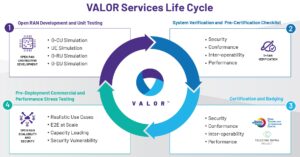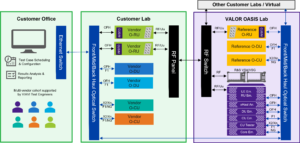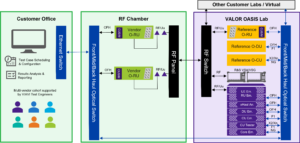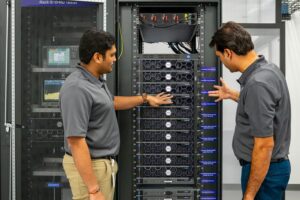
LaaS Testing can streamline deployment and enhance efficiency for reliable Open RAN
The race to build 5G networks has gone on for several years, extending coverage and providing access to advanced services. Initiatives such as Open RAN make for high-performing, robust, and agile mobile infrastructures that are in the interest of consumers and businesses, as well as the wider economy.
Open RAN gives network-equipment vendors the flexibility to deliver new products and accelerate the pace of progress. By promoting modularity, Open RAN lets incumbents and new market entrants — especially smaller, focused companies including startups and scale-ups — benefit from new business opportunities, cost-efficiencies, and flexibility.
Conformance and interoperability
Open RAN network components must provide expected features and performance, including interoperability with equipment from other vendors. Testing and certifying Open RAN components, however, presents challenges due to ecosystem complexity and diversity. Open RAN’s disaggregated architecture, which connects the network components over standardized interfaces while decoupling hardware from software, demands rigorous interoperability testing to ensure seamless integration across multi-vendor environments. Key challenges include ensuring performance consistency, managing diverse hardware configurations, and adhering to evolving standards.
Vendors must consider the need for comprehensive conformance and interoperability testing, robust security measures, and the potential impact of hardware variations on network performance. Additionally, they must navigate the evolving certification processes, which require collaboration with industry bodies and adherence to stringent regulatory requirements. Addressing these challenges is crucial for network equipment manufacturers to deliver reliable, scalable, and secure Open RAN networks.
The O-RAN Alliance has set out requirements for certification, which confirms conformance to specifications, and badging that covers interoperability (or end-to-end functionality in the case of a complete O-RAN solution). Testing is done at an Open Testing and Integration Center (OTIC) approved by the Alliance.

Figure 1. Open RAN equipment testing lifecycle includes development, verification, certification, and stress testing.
Before formal compliance testing and repeatedly throughout development, product manufacturers need to test their equipment to assess performance, interoperability, and security, including fixing any vulnerabilities and meeting industry security standards. Moreover, approved equipment needs to be tested in a realistic environment before deployment, including stress testing at scale. Figure 1 illustrates the test lifecycle.
Closing the Open RAN test gap
Setting up suitable in-house testing, including equipment, premises, and staff, can be expensive for smaller companies that are among key targets the Open RAN initiative is seeking to enthuse and invite to the market. On the other hand, access to test services is insufficient. Together, these two factors create a barrier. Availability and affordability of continuous testing services, which are essential during product development, and ultra-high-capacity load and stress testing typically needed at pre-deployment, are inadequate.
The emergence of hybrid physical and cloud-based Lab-as-a-Service (LaaS) models such as VALOR — VIAVI Automated Lab-as-a-Service for Open RAN — is helping to address these issues. The U.S. National Telecommunications and Information Administration (NTIA) awarded a $21.7 million grant from the Public Wireless Supply Chain Innovation Fund (PWSCIF) to build the test lab. VALOR is an “on-demand” test lab that assists engineers with product development and pre-compliance testing, as well as pre-deployment testing in realistic operating conditions. Services range from cloud-based environments for preliminary testing to extensive multi-cell load and stress testing, which have previously been inaccessible to smaller companies.
Testing is highly automated and comprises a cloud-based lab portal and access to a physical lab in Chandler, Arizona (Figure 2). Physical test time can be booked through an online portal and the hardware shipped in advance. Software testing is cloud based, fully virtual, and available on a 24/7 basis.
The LaaS model coexists with current existing industry testing labs. VALOR became the first such service to be authorized by the Telecom Infra Project (TIP) for their system performance certification program. By helping vendors prepare for certification, badging, and acceptance tests at Open Testing and Integration Centres (OTICs) and approved labs, LaaS eases pressure on services and helps accelerate new product time-to-market.
Accessible and affordable
Funded by the NTIA PWSCIF, VALOR will make functional/conformance testing affordable through cloud-based access to VIAVI’s node emulators, namely the multi-user equipment (UE) emulator, O-RU (radio unit), O-DU (distributed unit), O-CU (centralized unit) and Core emulators so that testers can perform the functional tests as they mature in product implementation. Figure 3 shows a diagram of the test process.

Figure 3. VALOR process for a device under test includes the ability to emulate radio units (O-RU), distributed units (O-DU), and centralized units (O-CU), which form an Open RAN network.
The platform provides an on-demand test suite for handling the entire product lifecycle from functionality to high-capacity stress tests. Test equipment covers conformance and performance testing for radio units (O-RU), distributed units (O-DU), centralized units (O-CU), end-to-end testing, and interoperability testing. The lab uses emulated equipment or real reference units in accordance with test specifications from applicable O-RAN Alliance working groups. Security tests address all 3GPP and O-RAN working group specifications and include O-RAN pre-badging as well as comprehensive vulnerability tests such as denial of service (DoS), fuzzing, open fronthaul (OFH) interface testing, port scanning, and O-CLOUD security. Testing with large numbers of emulated user equipment (UEs), applying various channel conditions and traffic patterns, is also available.
Figure 4 shows how VALOR uses VIAVI Automation Management and Orchestration System (VAMOS). Integrated with the VIAVI NITRO Wireless portfolio, VAMOS automates test campaigns, cases, and executions in a single cloud-based platform.
Customizable workspaces and configurations streamline the testing process and improve resource use across teams and lab locations. Shared tool testbeds and individual sandboxes accommodate many test needs, while the platform’s analytics and reporting help maximize test resource utilization and boost test accuracy.

Figure 5. The VALOR OTA testing process includes an RF chamber to isolate radio units from the ambient RF environment.
VALOR provides access to subsystem testing for conformance, performance and interoperability. There is also end-to-end testing with core emulation, as well as RIC tests covering conformance and performance validation and training of rApps and xApps. The service will ultimately offer over 500 test cases compliant with O-RAN WG4 (Working Group 4), WG5, WG11 and TIFG (Test & Integration Focus Group) specifications (see O-RAN Alliance specification pages for documentation) as well those from 3GPP. In addition, a large (25’ x 35’) anechoic chamber from ETS-Lindgren and RF test equipment from Rohde & Schwarz will be available for Massive MIMO and beamforming over-the-air (OTA) performance testing, shown in Figure 5.
Improving certification and deployment test-pass rates
Open RAN brings modularity to the mobile radio-access network infrastructure, making the market more accessible to companies of all sizes. While disaggregation can encourage competition and accelerate advancement, practical challenges can dissuade smaller companies from entering. Setting up a lab for development, pre-certification and badging, and pre-deployment testing is expensive. On the other hand, access to commercial lab services is sparse.
Hybrid on-demand Lab-as-a-Service models address these shortcomings. Combining online and real-world services eases access challenges and reduces costs, while support for O-RAN Alliance and 3GPP specifications enables testing in accordance with applicable industry standards for security, conformance, interoperability, and performance.
Additionally, there are steps that engineers can take to identify and address issues even before coming to a professional lab such as VALOR. The following outlines six steps that will help increase the chance of passing the rigorous certification and deployment tests:
- Perform Initial Conformance Tests
O-RU, O-DU and O-CU should be validated against baseline specifications, with
functional tests conducted to ensure basic operation of the devices. - Focus on Interoperability
Small-scale tests should be set up to check basic interoperability between multi-vendor components, such as the fronthaul communication between an O-RU and O-DU. Open-source testing tools or emulators can be used for this. - Conduct Preliminary Security Checks
Common vulnerabilities, such as port scanning or basic denial-of-service scenarios, should be scanned for, with compliance validated against baseline O-RAN security requirements. - Stress Test at Low Scale
While large-scale simulation will not be possible, it will be possible for some O-RAN developers to simulate a limited number of user equipment (UEs) to test how the system behaves under certain traffic loads. Where it is possible, experiment with various channel conditions and traffic patterns to identify performance bottlenecks. - Leverage Virtualized Tools
Software-based emulators and simulators can be used to test core functionalities before physical deployment. When doing this it is important to verify the software components work seamlessly across virtualized environments. - Document Results
Maintain detailed records of the testing methodology, results, and configurations used, which will be invaluable during professional lab testing and validation.









